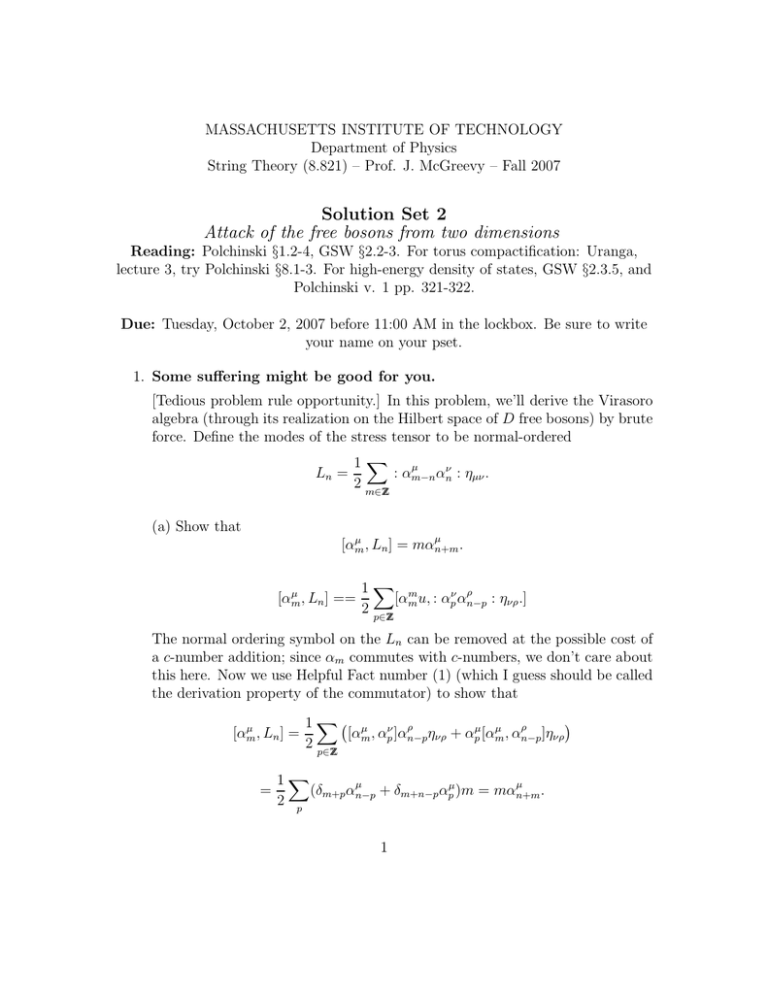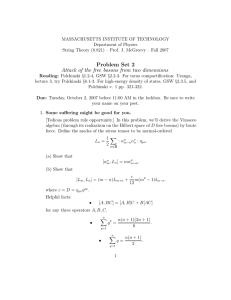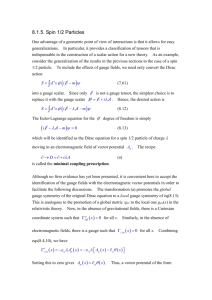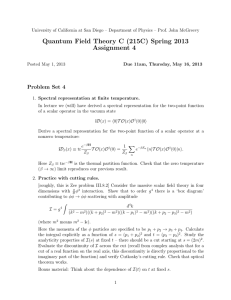MASSACHUSETTS INSTITUTE OF TECHNOLOGY Department of Physics
advertisement

MASSACHUSETTS INSTITUTE OF TECHNOLOGY Department of Physics String Theory (8.821) – Prof. J. McGreevy – Fall 2007 Solution Set 2 Attack of the free bosons from two dimensions Reading: Polchinski §1.2-4, GSW §2.2-3. For torus compactification: Uranga, lecture 3, try Polchinski §8.1-3. For high-energy density of states, GSW §2.3.5, and Polchinski v. 1 pp. 321-322. Due: Tuesday, October 2, 2007 before 11:00 AM in the lockbox. Be sure to write your name on your pset. 1. Some suffering might be good for you. [Tedious problem rule opportunity.] In this problem, we’ll derive the Virasoro algebra (through its realization on the Hilbert space of D free bosons) by brute force. Define the modes of the stress tensor to be normal-ordered 1X µ : αm−n αnν : ηµν . Ln = 2 m∈ZZ (a) Show that µ µ [αm , Ln ] = mαn+m . µ [αm , Ln ] == 1X m ρ [αm u, : αpν αn−p : ηνρ .] 2 p∈ZZ The normal ordering symbol on the Ln can be removed at the possible cost of a c-number addition; since αm commutes with c-numbers, we don’t care about this here. Now we use Helpful Fact number (1) (which I guess should be called the derivation property of the commutator) to show that µ [αm , Ln ] = = 1X ρ ρ µ µ [αm , αpν ]αn−p ηνρ + αpµ [αm , αn−p ]ηνρ 2 p∈ZZ 1X µ µ (δm+p αn−p + δm+n−p αpµ )m = mαn+m . 2 p 1 (b) Show that [Lm , Ln ] = (m − n)Lm+n + c m(m2 − 1)δm−n . 12 where c = D = ηµν η µν . Helpful Facts: (1) [A, BC] = [A, B]C + B[AC] for any three operators A, B, C. (2) n X q2 = q=1 (3) n X q=1 n(n + 1)(2n + 1) . 6 q= n(n + 1) . 2 Note: If you insist, you could instead find the central charge using the method described in GSW §2.2.2 (and made into an exercise in Becker2 -Schwarz problems 2.13-2.15, p. 57). I will follow the brute force technique, since the other is explained in GSW. First get write out the normal ordering explicitly: 0 ∞ X 1X 1 X [Lm , Ln ] = [: αp · αm−p :, Ln ] = [αp · αm−p , Ln ] + [αm−p · αp , Ln ]. 2 p∈ZZ 2 p=−∞ p=1 Now we use Helpful Fact (1) again on each term, and the result of part (a) to get [Lm , Ln ] = 0 1 X ((m − p)αp · αm+n−p + pαn+p · αm−p ) 2 p=−∞ ∞ 1X ((m − p)αm+n−p · αp + pαm−p · αn+p ) + 2 p=1 Note that in every term the mode numbers always add up to the same number (m + n) – this is a consequence of translation invariance in σ on the worldsheet, i.e. it’s worldsheet momentum conservation. Next 2 rename the summation variable in the second and fourth terms to q = p + n: 0 n 1 X 1 X (m − p)αp · αm+n−p + (q − n)αq · αm+n−q [Lm , Ln ] = 2 p=−∞ 2 q=−∞ + ∞ ∞ 1 X 1X (m − p)αm+n−p · αp + (q − n)αm+n−q · αq 2 p=1 2 q=n+1 Assume n > 0 for a moment (n ≤ 0 is similar). Relabel the summation variable in the first and third terms p = q. Then the first two terms can be combined using the identity m − p + p − n = m − n, except for the q = 1...n entries in the second term. A similar thing happens with the third and fourth, leaving 0 n 1 X 1X [Lm , Ln ] == (m − n)αq · αm+n−q + (q − n)αq · αm+n−q 2 q=−∞ 2 q=1 + ∞ ∞ 1 X 1X (m − n)αm+n−q · αq + (m − q)αm+n−q · αq 2 q=n+1 2 q=1 Except for the second term in this last expression, it is already normal ordered. Twice the second term is n X q=1 (q − n)αq · αm+n−q = n X q=1 (q − n)αm+n−q · αq + n X q=1 (q − n)qDδm+n where D = η µν ηµν is the number of dimensions. So: ∞ n 1 X 2 1 X (m − n)αq · αm+n−q + D (q − nq)δm+n [Lm , Ln ] == 2 q=−∞ 2 q=1 Using Helpful Facts (2) and (3) to do the two sums gives finally the Virasoro algebra: [Lm , Ln ] = (m − n)Lm+n + 3 D 3 (m − m)δm+n . 12 2. Virasoro operators really do generate conformal transformations. Recall that fixing conformal gauge in the Polyakov theory leaves a residual gauge invariance: reparametrizations of the form σ ± 7→ σ̃ ± (σ ± ) change the metric in a way that can be compensated by a Weyl gauge transformation, preserving the form of the metric. Such transformations are called conformal transformations. The infinitesimal form of such a transformation is σ̃ ± − σ ± ≡ δσ ± = ξ ± (σ ± ). This is two functions worth of transformations (an infinite-dimensional group), a useful basis for which is Fourier modes: ± imσ . δǫ±m σ ± = ǫ± me Under this transformation, a scalar on the worldsheet transforms as X(σ + , σ − ) 7→ X(σ̃ + , σ̃ − ) = X + δǫ X with X imσ± (⋆) δǫ X = ǫ± ∂± X. me m,± When quantizing the string, after some circuitous logical meanderings, we discovered that we should impose (Lm − δm a)|physi = 0 = (L̃m − δm a)|physi, m>0 on physical states. Using the canonical commutation relations, show that the operators Lm , L̃m indeed generate the transformations (⋆) by commutators, i.e. − δǫ X = i[ǫ+ m Lm + ǫm L̃m , X]. Note: If you prefer, do this problem with a euclidean worldsheet, using com+ − plex coordinates on the plane (i.e. replace eiσ with z and eiσ with z̄ ). Only the notation is different. I’m just going to show the left-moving bit; the right-moving version is identical. The mode expansion of X (in α′ = 2 units) is X(σ + , σ − ) = x + pτ + i X αn n∈Z Z 4 n + e−inσ + i X α̃n n∈Z Z n − e−inσ . Plugging, we get ! X X Xi + [ ǫ+ ǫ+ e−inσ [Lm , αn ] + [Lm , x̂] m Lm , X] = m n m m n6=0 The zeromode p ∼ αn=0 drops out because [Lm , α0 ] = 0. More genµ erally, from the previous problem we have [Lm , αnµ ] = −nαn+m . We mustn’t forget the center-of-mass position, x̂, term in X, however1 , which has (restoring units for a moment) # "r r r 2 2 2 µ pν , x̂µ = −i η νµ =⇒ [Lm , x̂µ ] = −i α . [α0ν , x̂µ ] = − ′ ′ α α α′ m So [i X ǫ+ m Lm , X] = i m X + µ −inσ ǫ+ αn+m m (−i)e m,n6=0 = X + i(m−(n+m))σ ǫ+ αn+m me m = −i X imσ+ ǫ+ me m X −iqσ+ αn e q ! = X + imσ ǫ+ (∂+ X) me m 3. A simple 2d GR problem. (a) Find the Christoffel symbols Γkij (i, j, k = z, z̄) for the conformal gauge metric ds2 = e2ω(z,z̄) dzdz̄. The only nonzero ones are Γzzz and Γz̄z̄ z̄ : ¯ Γzzz = 2∂ω, Γz̄z̄z̄ = 2∂ω. (b) Show that the covariant expression for the reparametrization FP ghost action Z √ 1 d2 σ γbab ∇a cb Sgh = 2π 1 Thanks to Koushik Balasubramanian for reminding me of this. 5 (here ∇ is the metric-compatible covariant derivative) reduces in conformal gauge to Z 1 d2 z (bzz ∂z̄ cz + bz̄ z̄ ∂z cz̄ ) . Sgh = 2π √ √ [note that γ ≡ − det γ by definition]. The nonzero Γs aren’t the ones that appear above, so the derivatives reduce to ordinary ones. (c) [bonus] Find the Ricci scalar for the conformal gauge metric. The Riemann tensor has only one component (up to symmetries): z ¯ Rzz z̄ = −∂∂ω. ¯ The Ricci tensor is Rz z̄ = Rz̄z = −2∂∂ω, so the Ricci scalar is ¯ R = −8e−2ω ∂ ∂ω. 4. Kaluza-Klein decomposition. (a) Find the (D − 1)-dimensional spectrum of fields (i.e. their masses) that arises by compactifying a single free massive scalar field φ on a circle of radius R, governed by the action Z SD [φ] = − dD x ∂M φ∂ M φ + m2 φ2 (1) where the indices M, N = 0..D − 1; we’ll reserve µ, ν = 0..D − 2 for the noncompact directions. (Note: No gravity yet.) [Hint: expand the field in a basis of single-valued functions on the circle on which the translation operator eip̂y (y ≡ xD−1 ) acts diagonally.] P iny/R Expand φ(y, x) = n∈ZZ e√2πR φn (x). Note that the reality of φ means φn = φ−n , just like for free bosons on the cylinder. Then the wave equation is X n2 2 2 2 2 0 = (∆D − m )φ = (∆D−1 + ∂y − m )φ = ∆D−1 − 2 − m φn R n So the mass of the nth KK mode is m2n = m2 + 6 n 2 R . (b) In lecture 4 I claimed that compactifying D-dimensional GR on a circle produced a D − 1-dimensional graviton gµν , a D − 1-dimensional gauge field Aµ , and a scalar field σ (plus all of their massive KK harmonics). Demonstrate that this is the case (to your own satisfaction) starting from the ansatz for the D-dimensional metric ds2 = GM N dxM dxN = e2σ (dy + Aµ dxµ )2 + gµν dxµ dxν . where y ≡ y + 2πR is the coord on the circle. (e.g. you might want to show that the D-dimensional Einstein-Hilbert term Z √ 1 D d x GRD (D) 8πGN produces kinetic terms for g, A, σ.) [Hint: use the gauge invariance Aµ → Aµ + ∂µ ǫy (x) (which is a subgroup of the D-dimensional coordinate invariance) to constrain the possible terms in the Lagrangian.] I claimed further that the charge to which the gauge field coupled was the KK momentum (i.e. the momentum along the circle). As a test of this claim, couple the scalar in part (a) to D-dimensional gravity – i.e. replace (1) with the fancy covariant expression Z √ SD [φ, G] = − dD x G ∇M φ∇N φGM N + m2 φ2 . – and show that this expression includes a minimal coupling between A and any mode of φ which carries momentum along the circle, with strength proportional to the momentum. The first part of this question is reviewed in Polchinski §8.1 . Specifically, he finds that the D-dimensional Ricci scalar, in the ansatz above, is 1 R(D) = R(D−1) − 2eσ ∇2 eσ − Fµν F µν , 4 so we see possible kinetic terms for the lower-dimensional metric, the KK gauge field and the radion scalar σ. Note that gauge invariance restricts the possible terms on the RHS to the ones appearing here times possible functions of σ. The coefficient functions can be determined by investigating special cases of the ansatz. 7 To find the charge of a KK mode, let’s focus on a mode of the minimally coupled scalar φ, and in particular its kinetic term, which is (note that on scalars we don’t need the fancy derivatives) ∇M φ∇N GM N . Unfortunately, we need here the inverse metric for the ansatz above. In matrix form, −2σ e Aµ , GM N = Aν gµν + e2σ Aµ Aν M N so with some help from Mathematica, I get M N −2σ e + A2 −Aµ MN G = −Aν g µν where µ, ν indices are all raised and lowered hopefully √ with gµν and √ −σ (D) det g, we the block notation is clear. Using this and det G = e get √ det G(D) ∇M φ∇N GM N = e−2σ + A2 (∂y φ)2 − 2Aµ (∂y φ)(∂µ φ) + ∂µ φ∂ν φg µν . Plugging in the KK for φ and integrating over the extra R expansion i(m+n)y/R dimension (using dye = 2πδm+n , and ignoring KK modes of A and g!) gives Z √ dy02πR G(D) ∇M φ∇N GM N n 2 n 2 √ −σ X n µν 2 −2σ = ge φn φ−n − A φn φ−n + 2i A · ∂φn φ−n g ∂µ φn ∂ν φ−n . −e R R R n∈Z Z The action for the couplings of the KK modes of φ to the zeromode of the gauge field is then Z n 2 X √ S = − dD−1 x = g e−σ φn φ−n (−e−2σ R n∈Z Z n n µ − ∂µ φn − i φn ∂ φ−n − i φ−n + g µν ∂µ φn ∂ν φ−n ) . R R This is a minimal coupling of the nth KK mode to A with charge proportional to n. (c) What is the D−1-dimensional Newton constant in terms of the D-dimensional (D) one, GN ? What is the gauge coupling for the KK gauge field (i.e. the unit 8 of electric charge)? Do the engineering dimensions of all these quantities make sense? 1 R (D−1) (D−1) 16πGN (D−1) plus the fact that gµν + ... = 1 (D−1) 16πGN Z 2πR dyR(D) 0 (D) is a zeromode of gµν says 1 (D−1) 16πGN = 2πR (D−1) 16πGN . In terms of the D and D − 1-dimensional Planck masses, 1 (D) (MP )D−2 ≡ (D) 16πGN , this says (D−1) MP 1/D−3 (D) D−2 = 2πR(MP ) . Note that the BHS has dimensions of mass. The coupling between A and φ was n/R. By rescaling A → Ã ≡ RA, we can put the R in front of the gauge field kinetic term: Z 1 1 1 dy(− eσ F 2 ) = − 2πReσ R2 F̃ 2 (D) (D) 4 16πGN 4 · 16πGN 1 (D) 1 = − MP 2πR3 eσ F̃ 2 ≡ − 2 F̃ 2 4 4gY M So we identify the D − 1 dimensional gauge coupling as 1 gY2 M (D) = MP 2πR3 (assuming heσ = 1i) , which indeed has the right dimensions to be the gauge coupling of a D − 1 dimensional gauge field. (d) [Bonus Q] What do you get if you compactify pure gravity on a space with isometry group G? As you might expect you get nonabelian KK gauge symmetry. The best way to see this is to use the killing vectors to construct the ansatz. It’s a hard to get chiral matter in representations of these gauge groups, at least from smooth geometries. 9 5. No Goldstone bosons in two dimensions. [This is really more a diatribe than a problem.] (a) Show that the euclidean 2d massless scalar Green function G2 ∇2 G2 (z, z ′ ) = −2πδ 2 (z − z ′ ) (Gerbil) (z = σ1E + iσ2E ) is given by G2 (z, z ′ ) = − ln |z − z ′ |, for example by Fourier transform. Translation invariance says ′ ′ G2 (σ, σ ) = G2 (σ − σ ) = Z dd k ik·(σ−σ′ ) | e G̃(k). d=2 (2π)d The Fourier transform of (Gerbil) is −k 2 G̃(k) = − 1 . 2π Back in position space, Gd (z, 0) = G2 (z) = = c , |σ|d−2 − ln |z|, Z dd k 1 ik·σ e (2π)d k 2 d 6= 2 d=2 . [I wasn’t careful about the factors of −1 and π in doing the Fourier transform, but the final coefficients can be checked by taking box of both sides and comparing to (Gerbil).] Note that the bad IR (large σ) behavior of the Green’s function gets even worse in d < 2. (b) The long-distance behavior of G2 has important implications for the physics of massless scalars in two dimensions. Thinking of G2 as the two point function of a massless scalar G2 (z, z ′ ) = hX(z)X(z ′ )i, let’s ask the following question: There is no potential energy for the field X in the Polyakov Lagrangian. A four-dimensional physicist Someone used to physics in (3+1)-dimensions might 10 think that this means that there is a vacuum for every value of X, i.e. that X is a modulus. Let’s try to fix the expectation value of the scalar hXi = x and see what happens. Perturb the (conjectured) vacuum |xi a little bit at the worldsheet position z by inserting the operator X there. To measure what happens, we insert the operator X at z ′ . The correlator G2 can thus be interpreted as a measurement of how the effects of our perturbation fall off with distance. What happens? Contrast this with the behavior you would see for a scalar field with a flat potential in three or more (really 2 + ǫ) dimensions. It may be useful to remind yourself about the (even more dramatically infraredproblematic) case of (0+1) dimensions, i.e. QM. Note, by the way, that the Goldstone-ness of the massless bosons (i.e. whether they are massless because of a symmetry) is not crucial. In non-supersymmetric sigma models, one expects massless bosons whose mass is not protected by a symmetry to be lifted quantumly, but in supersymmetric theories, this need not be the case. So this story is also important for supersymmetric NLSMs where the target space has no continuous isometries, as is the case for Calabi-Yau manifolds. This result is called the Coleman-Mermin-Wagner theorem (sometimes Hohenberg, too). For help, read S. Coleman, “There are no Goldstone bosons in two-dimensions.,” Commun.Math.Phys. 31:259-264 (1973). A familiar fact is that non-relativistic QM of a particle in a potential with degenerate minima does not have degenerate vacua. Tunneling between the minima leads to mixing; the true vacuum is some superposition. If the potential minima are related by a symmetry, the vacuum does not spontaneously break the symmetry, it is a symmetric superposition. A less extreme version of this in QM, which also won’t surprise you, is that for a particle with no potential, a localized wavefunction will spread out, and the ground state is uniform. Though these effects aren’t usually described in these terms, the long-distance growth of the d < 2 propagator we saw in part (a) is a direct signal of them. And the fact that ln |σ − σ ′ | grows at large separation means that a similar thing happens in two dimensions: if we try to localize the vev of X̂, it will be washed out by fluctuations, and the ground state wavefunctional for the free boson is really a sum over values of X. This is exactly what we accomplish by integrating over the target space of the boson in the path integral. 11 If the boson field space is not swept out by the action of some symmetry (for example if the kinetic terms do not respect the symmetry, but nevertheless the boson remains flat quantum mechanically, e.g. because of supersymmetry), it just means that this sum is not weighted with the uniform distribution. In conclusion, 2d massless bosons exist and can be quite sensible and interesting, they just aren’t Goldstones ever. 6. The guts of the Veneziano amplitude. Consider a collection of D twodimensional free bosons X µ governed by the action Z 1 d2 σ∂a Xµ ∂ a X µ . S=− 4π (a) Rotate eiS to Euclidean space (d2 σ = −i(d2 σ)E ) and compute the Euclidean generating functional Z E D R 2 R 2 µ −1 (d σ)E J µ Xµ [dX]eiS e (d σ)E J Xµ ≡Z Z[J] = e (where Z ≡ Z[J = 0], but please don’t worry too much about the normalization of the path integral.) [Hint: use the Green function from the previous problem and Wick’s theorem.] In euclidean space, 1 S=− 4π Z (d2 σ)E (−i)(−∂a Xµ ∂ a X µ ). So the Boltzmann factor in euclidean space is Z 1 iS −SE (d2 σ)E ∂a X · ∂ a X. e =e , SE = 4π The generating functional is R ZE [J] = he (d2 σ)E Jµ X µ =Z =e 1 2 R −1 Z (d2 σ)E J µ 2π2 Jµ ∂ i=Z −1 R [DX] e =e 1 2 R Z R [DX] e (d2 σ)E ( ∂X·∂X +J·X ) 4π ” “ 2 (d2 σ)E − X∂4π X +J·X R (d2 σ1 )E (d2 σ2 )E J µ (σ1 )( 2π2 ) 12 ∂ σ1 ,σ2 Jµ (σ2 ) The Green function from the previous problem is 2π = − ln |z1 − z2 |. G(σ1 , σ2 ) = ∂ 2 σ1 ,σ2 So we find 1 Z[J] = e 2 R d2 z1 R d2 z2 J µ (z1 ,z̄1 ) ln |z1 −z2 |Jµ (z2 ,z̄2 ) (b) Show that * N Y + √ −i 2α′ ki ·X(σ(i) ) :e : i=1 = N Y ′ i,j=1 |zi − zj |α ki ·kj (i) (i) where σ (i) label points in Euclidean space, zi = σ1 + iσ2 , α′ is the Regge slope, and kiµ are a set of arbitrary D-vectors in the target space. relative to our [Note: In the last two problems I’ve rescaled Xusual = X√here α′ usual normalization of the free bosons – these X variables are dimensionless in the target space.] Choosing the source J to be N X √ ′ kiµ δ 2 (σ − σi ) J = −i 2α µ i we get *N Y √ −i 2α′ ki ·X(σ(i) ) :e i=1 + : ′ = eα PN i,j=1 ki ·kj ln |zi −zj | which reproduces the stated expression. There is a bit of an important lie here, though. The field theory in which we’re calculating this correlator has a symmetry X µ 7→ X µ + constµ , which is translation invariance in the target space. The resulting conserved charge is momentum, k units of which is injected into the correlator by the operator eikX . But the fact that charge is conserved (and not eaten by the vacuum) means that there should be a law saying that amplitudes predicting nonconservation should P vanish: The amplitude should be proportional to δ D ( i kiµ ). What did we leave out? We left out the zeromode of X µ (I’ll call it xµ ), 13 which means that ∂ 2 isn’t really invertible (it’s only invertible on a subspace of the configuration space which cuts out the zeromode, and that’s when its inverse is G ∼ ln ..). Putting it back in is simple: the zeromode doesn’t appear in the kinetic term for X, only in the J · X term. With our choice of J above, the zeromode integral is ! D−1 YZ X µ PN µ dxµ ei i=1 ki xµ ∝ δ D ki µ=0 i 14









